The newest form of physical infrastructure we consider also attracts strong bipartisan support for new investments. Democrats and Republicans agree that the accessibility of high-speed internet connections for homes and businesses is increasingly important. Because both rural areas and lower income urban areas are underserved, broadband tends to bridge the usual partisan divides.
The country’s broadband infrastructure made it into the ASCE Report Card for the first time in 2021. Because the category is so new they did not have the same metrics and comparisons as they do for other kinds of infrastructure. Consequently, they did not give it a grade or estimate how much more funding is needed. The report concluded that “American’s reliance on fast internet is only forecasted to grow in coming years.”
President Biden and Senate Republicans not only agree that broadband deserves significant new funding, they also now agree on just how much more. The American Jobs Plan originally called for $10 billion in new broadband spending per year but reduced it to $8.1 billion to match Senate Republicans’ plan. Because the Common Sense Coalition plan that President Biden now supports calls for spending the same total amount over the shorter five year time period, that plan works out to $13 billion each year in new broadband funding. The Problem Solvers Caucus calls for $5.6 billion per year in new spending.


